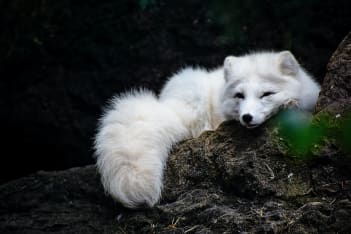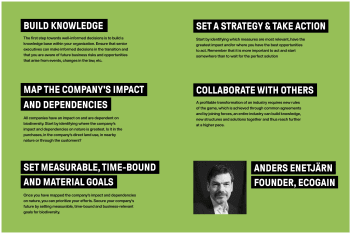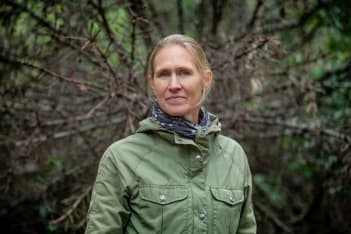
Biodiversity
TND Insights is a theme based content series in which we highlight relevant topics that we – and probably others – find complex. First out is biodiversity - what is it, why is it important and how we can work in order to prevent the current loss of plants, insects, and ecosystems? We will also provide you with insights from inspiring experts. Let's go!

The Arctic fox is today listed as "Least concern" by WWF globally, but the population in Norway, Sweden and Finland has plummeted to just 250 - despite being legally protected for several decades. Photo: Teresa on Unsplash.
What is it and why is it important?
Biodiversity derives from the words biological and diversity, referring to the variety of life that can be found here on earth. It constitutes all living organisms surrounding us – plants, animals, insects, and ecosystems. Climate, biodiversity, and water should all be interconnected when setting sustainability goals for the future. In the report “30 by 30”, WWF has set an ambition for 2030: ” Protect at least 30% of the planet and sustainably manage the rest.
We tend to forget that we are entirely reliant on biodiversity to support us with both human and societal needs such as food, energy, freshwater, and the development of medicines. One well-used example demonstrating our need for biodiversity is the importance of bees, wasps, and butterflies. In 2018, a report concluded that pollinators affect 35% of global agricultural land, supporting the production of 87 of the world-leading food crops worldwide.
The conversion of natural habitats into urban areas (urbanization) causes a significant loss of biodiversity, but there are things that we can do to prevent some of that loss.
By integrating meadows (instead of homogenous grass fields), green roofs, and parks with more diverse plants into our cities, we can create an environment increasing the possibilities of preserving biodiversity.
Global Goals 14 and 15 aim toward conserving and protecting life below water and life on land - making them two of the most important goals for societal and planetary health. Even though we are dependent on biodiversity for our way of life, it is unfortunately deeply down prioritized.

The Global Goals #14 and #15.
Nordic companies + biodiversity
Ecogain, an organization that executes an index for biodiversity, has for the second time-analyzed and evaluated the sustainability reports of the biggest companies in Sweden, Finland, Denmark, and Norway. According to Ecogains report, that was released in May of 2021, Sweden is at the bottom of the list when it comes to identifying, setting targets, implementing actions, and monitoring biodiversity.
We had the opportunity to speak to Anders Enetjärn, founder of Ecogain who stated that “We can see that the business community is slowly waking up to the issue of biodiversity, but we must accelerate the development to have a chance to stop, and reverse the loss of nature. Biodiversity directly or indirectly affects all 17 of the UN's 17 Global Sustainability Goals *, in particular the climate, and it is a huge business risk not to take this into account. A holistic approach is required in the sustainability work; it is not possible to secure the future of either the company or the entire planet by trying to tackle one issue at a time. "
Many organizations ask themselves; where to start? It is not always easy to tackle a "new" issue, or to see how the current sustainability work relates to biodiversity. Below are Ecogain's 5 quick tips for how to get started. A more detailed description can be found in the Ecogain Biodiversity Index 2022.

Insights from an expert
The business sector has a big impact on biodiversity. Even if it is part of the problem, it is also part of the solution as its resources and influence offer important opportunities for innovations that can help protect biodiversity. We have talked to Louise Karlberg at Naturskyddsföreningen who shared some of her thoughts.
What can companies/organizations do today to contribute to increased biodiversity?
– The main reason for the loss of biodiversity in Sweden is due to our unsustainable usage of land. By requesting more sustainable products, such as organic food or timber that comes from close-to-nature forestry, companies can contribute to increased biodiversity and at the same time, support the landowners that are making an important contribution to the environment.
What issues relating to biodiversity will Naturskyddsföreningen put extra focus on during 2022?
– In 2022, we will continue our work to get consumers and the public sector to choose organic products. We will work hard to convert forestry into becoming more close-to-nature and to increase the protection of areas with high nature value to land and sea. We will also make an extra effort to protect the bees in our campaign “Save the Bees!”
What needs to happen globally (politics, frameworks, policies) for biodiversity to be prioritized in alignment with Agenda 2030?
– We can see that the EU is conducting very progressive politics within the ‘European Green Deal’ to strengthen biodiversity. It needs to result in binding legislation and clear targets. Sweden needs a sharper policy worthy of a country with a high profile in sustainability. We cannot continue to push back on processes such as the EU forest strategy, land use, land-use change, and forestry (LULUCF) and the taxonomy, but we need to further develop the opportunities that the green transition can bring to us as a nation.

Louise Karlberg, Naturskyddsföreningen
What can I do to contribute?
The rate at which plant and animal life are disappearing from earth is tens or hundreds of times faster than in the past. Today, more than one million species on earth face extinction. It is easy to feel discouraged, but there are things that we as individuals can do to protect and preserve biodiversity. Here are some tips:
Support local farms
Buy organic groceries from small local farmers or market places to help support agricultural efforts that conserve biodiversity.
Protect the bees
You can help to protect and save the bees by planting nectar-producing wildflowers in your backyard, or building small bee boxes for local bees to call home. If you are planning to make your own bee-box, be mindful of the products you use!
Create a beautiful and diverse garden
Research flora, fruits and vegetables native to your area and plant a variety in your backyard. This way, you can create an ecosystem, in which plants, insects and animals can thrive.
Don’t waste water
Biodiversity is dependent on local fresh water. By taking shorter showers, turning off the water while brushing your teeth or doing your dishes, you can help to conserve water.
Respect local habitats
Plants growing in the parks and nature reserves play an important role in preserving local ecosystems. When outdoors – stick to the walking path, and help your children and pets to do the same.
Choose your products wisely
Make sure that the products you buy are not contributing to destruction of habitats. Look for labels such as Forest Stewardship Council (FCS) or Rainforest Alliance Certified. Both organizations are committed to the conservation of the Earth’s resources and human rights of the native people who inhabit the land many products are sourced from.
Source: https://sustainability.yale.edu/blog/6-ways-preserve-biodiversity

Let's talk about sustainability strategy
Sara Lindström
Sustainability Strategist
sara@tnd.world
+46 70 225 62 24